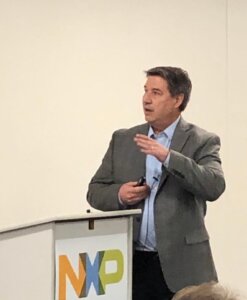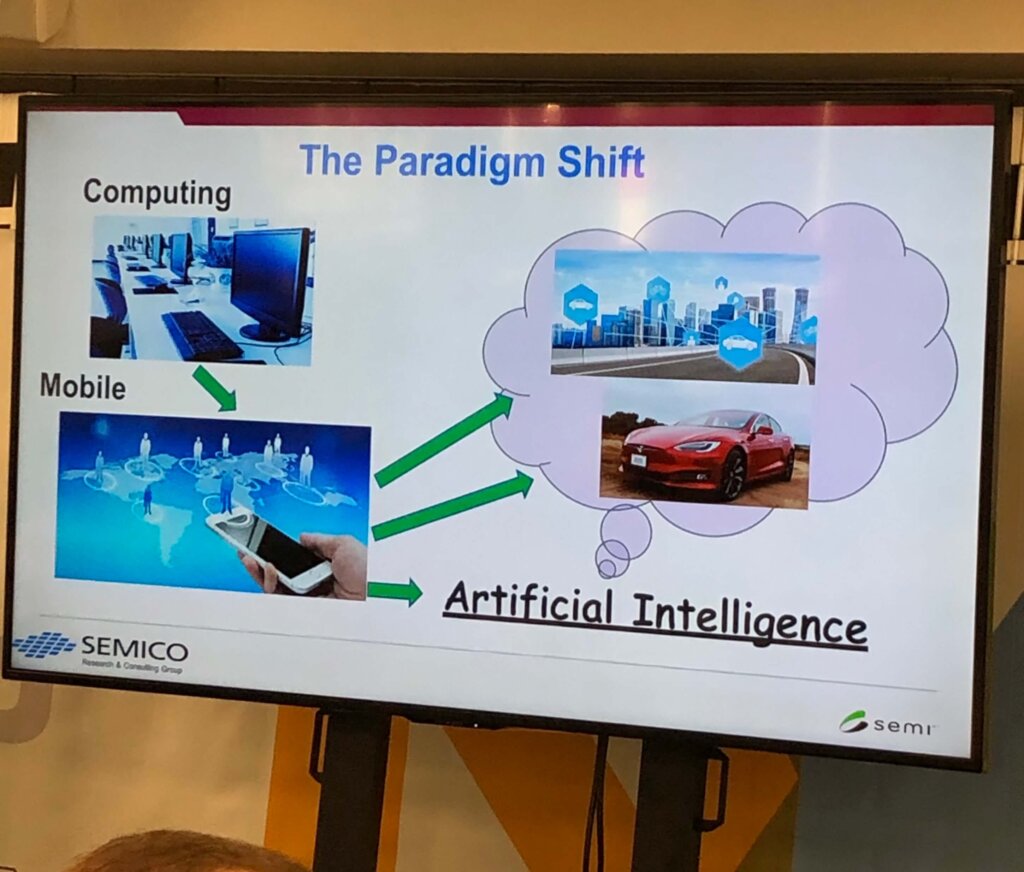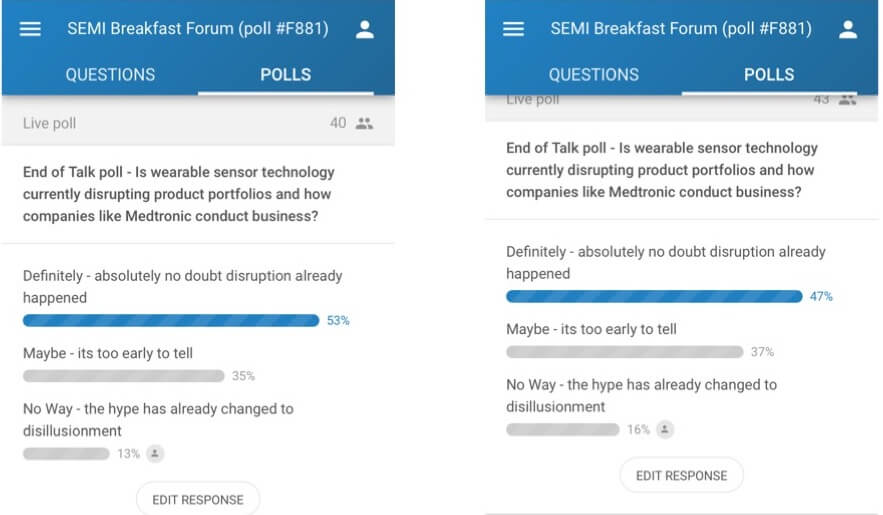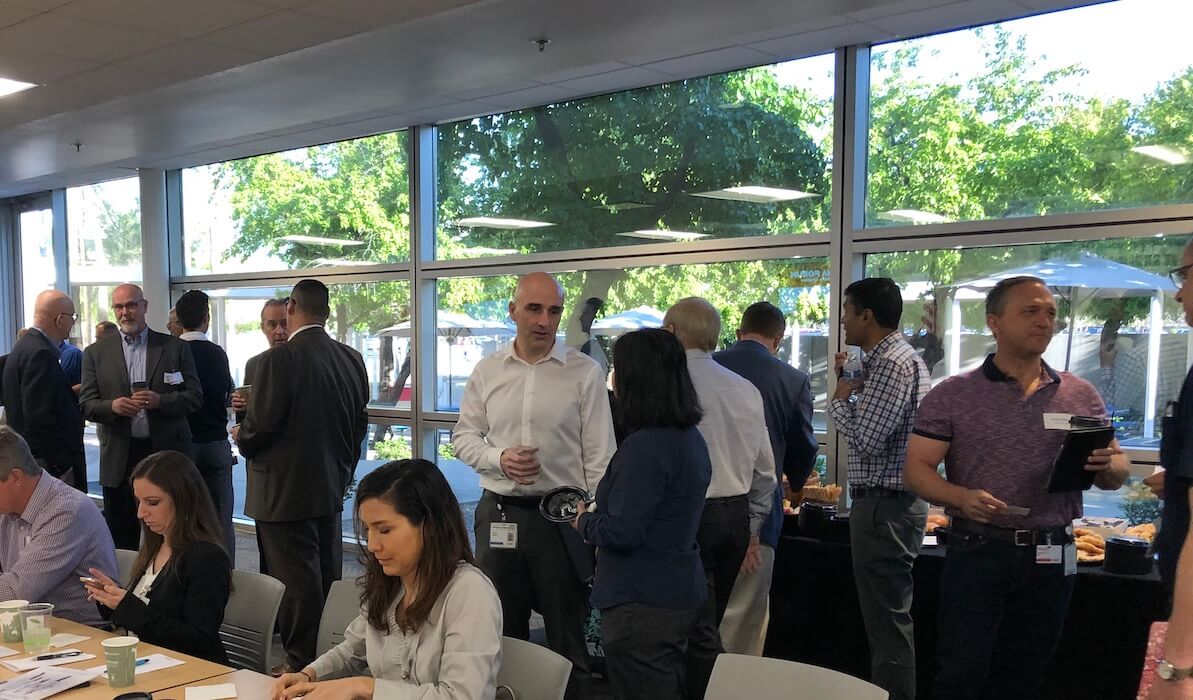Why are sensors not on the same growth trajectory as CMOS? In the face of a shaky global economy, where are the opportunities coming from? How will doctors practice medicine five years from now and how will MEMS and sensors be involved? What are some of the cool, upcoming sensor-enabled devices that will change how we interact with the world?
These questions and more were the topics of discussion at the SEMI Arizona Breakfast Forum, held Friday, March 28 at NXP Semiconductors in Chandler, AZ. The speaker line-up included Dr. Dave Monk, NXP; Jim Feldhan, Semico Research; Randy Schulhauser, Medtronic; and Garret Oakes, EV Group.
Are We on a Path to a Trillion Sensors?

You may remember the Trillion Sensor Initiative launched back in 2013 by Dr. Janusz Bryzek, who called for the development of 45 trillion sensors by 2025 to enable a world of Abundance. Abundance has been defined as a world without hunger; with medical care, clean water, air and energy for all. Bryzek predicted that Abundance could be reached in 20 years if we accelerated development cycles that historically last 30 years.
With only six years to go from that target date, Dave Monk says we’re not even close, and he knows why. The original prediction was made based on the assumption that as a semiconductor planar technology, MEMS should be able to grow as CMOS did. Except they haven’t. “Rather, volumes produced by MEMS manufacturers are a couple of orders of magnitude lower than CMOS manufacturers,” noted Monk. “This is an issue.”
Monk says the three missing ingredients between CMOS and MEMS are economies of scale, simplicity, and value. With MEMS, there are no “killer applications” like there was for the IC market; namely the iPhone. Instead, there are many applications with different supply chains and different challenges.
“With too many technologies in the mix, nothing became universal like CMOS,” he noted. He also said we need to shift our understanding of value: we need sensors that provide information, not just data.
NXP’s solution to this is the development of a universal MEMS (UMEMS) device with a standard flow to address physical (not chemical) sensors. UMEMS combines six technologies into a single universal sensor. “The goal is to convert 13 different flows down to one because a singular flow will help drive the economy of scale and volume,” Monk explained.
While it may not be possible (or necessary) to develop 45 trillion sensors by 2025, Monk offered an amended goal: 75 billion connected devices by 2025. Focusing on simplicity and economies of scale will help reduce costs and bring supply chain and quality improvements.
Sensing Opportunities offers Breaks in Dark Clouds
The next dose of reality came from Jim Feldhan, who said that after a good long growth cycle since the last recession, GDP growth is in a downturn. Political uncertainty, tariffs, trade wars, and a labor shortage are all contributing factors that don’t paint a picture of extended recovery. But lucky for us, we’re in the semiconductor industry, and there are some great opportunities despite the dark clouds.
Forget the desktop PC and smartphone markets – while they use MEMS and sensors, those markets are declining. Notebooks and laptop have seen a slight uptick, but the IoT market is where the real opportunity is for MEMS and sensors, particularly in edge devices, noted Feldhan.
“Agriculture is a big opportunity for MEMS and sensors,” he said. For example, dairy farmers use biometric sensing to monitor cows’ health and adjust their environment. Happy cows mean more milk!
“A paradigm shift is happening,” noted Feldhan. “The industry used to be driven by the computing market. But over the next five years, growth is in smart homes, smart cities, automotive, and AI; Hopefully to make our lives better.” (Figure 1)

Categorized by end market, Feldhan predicts that by 2023, communications will comprise 56% of the MEMS and sensor market, with consumer and automotive each making up 20%.
He also noted that the home automation market will be dominated by smart speakers, with over $5B units in that product category expected by 2023. The electronic vehicle market “is exploding” particularly in China (although not literally).
How Will People Practice Medicine in Five Years?
This is the question Randy Schulhauser’s team at Medtronics asks every day when they consider new technologies. The company’s goal is to be in this space through innovation, invention, and disruption.
MEMS and sensors are only part of the microelectronics in medical devices. “Not all of today’s devices are “smart,” he explained. “Many of them are still ‘dumb’. Our goal is to add the ‘smart.’”
And that’s where MEMS and sensors come in. Schulhauser categorizes MEMS and sensor technology by their degree of difficulty (DoD) to integrate, from easiest to hard: Electrical, physical, optical and chemical (EPOC). As new sensors are developed, there’s lots of back-end work needed before they can be integrated. The DoD is also impacted by the device’s proximity to the human body: lab assay, to hand-held, point-of-care (PoC), wearable, and implantable.
Lest we think medical devices are a great place to try new things, he had some news for us. “The medical technology industry does not drive technology,” he said. “It is a slow adopter of ‘people’s technology.’ It is a litigious environment driven by factual, clinical evidence. Approval takes time and adoption is slow.”
What does it take to commercialize a medical device? According to Schulhauser, it varies depending on the sensor technology. Commercializing a microminiature electrocardiogram (ECG) took 20 years and $20 million. A capacitive pressure capsule for blood pressure monitoring took 30 years and $100 million. And optical sensor to detect oxygen levels in the blood has been in development for 30 years with a $100 million spend, but still is not commercialized because of an issue with blood clots. However, a chemical sensor to detect glucose oxidase only took 12 years with $25 million spent.
And then there’s the matter of consumer wearables, such as fitness trackers and so-called health monitors. Are they clinically relevant? Schulhauser conducted a live audience poll before and after his talk: is wearable technology disrupting (medical device manufacturer) product portfolios?
A heart monitor study of 400K Apple watch wearers reported only 34% effectiveness. “Wearables are not medical devices,” said Schulhauser. “However, they can be triage indicators.” They may be lower cost, but only 2/3 of consumer wearables are standard-of-care (SoC) compliant. While they have a purpose, they are mislabeled as a medical disease management device because they lack SoC equivalency. Thus, Schulhauser says they are over-hyped.
At the beginning of the talk, more of the audience members thought disruption is already happening, while a smaller percentage thought the hype has changed to disillusionment. By the end, he had changed some minds (Figure 2).

Essentially, what is needed is a bridge between wearables and medical devices. The glucose sensor is the first example of that.
Cool Devices on the Horizon
Garrett Oakes wrapped up the morning with a look at some really cool digital devices and how the adoption of them is impacting our lives.
Adoption gaps are based on generation. While Millennials lead on some technology adoption measures, Baby Boomers and Gen Xers are also heavy adopters. Building voice commands for how we interact with our environments is leveling the playing field, noted Oakes.
The IoT
Before long, there will be more things connected to the Internet than people. Oakes noted there are now 340 undecillion IP addresses now possible. The power of this is evidenced, for example, the integration levels of traffic lights: Oakes says he uses GPS to navigate the fastest path to work based on when lights turn green. Smart homes becoming the norm is another indicator of the prevalence of IoT devices.
Smartphones and 5G
Our smartphones are steadily transforming from communications devices to personal identification devices with the addition of functionalities such as vehicle and home automation control, health monitors and digital wallets. Oakes said he thinks soon, our phones will replace our laptops: We’ll be able to dock them at home and the office.
On the flip side, some people are predicting the ultimate demise of today’s smartphone thanks to the promise of 5G coupled with advancements in AR/VR; voice gesture and gaze control, and the resurgence of smart glasses.
Digital Healthcare
On the digital healthcare front, Oakes pointed to some innovations that will improve the way we manage our health:
- The PillCam for gastrointestinal imaging includes a MEMS switch, an LED image sensor, and an RF device.
- Tablets containing disposable sensors track patient adherence to many factors of prescriptions.
- A fingernail sensor to monitor Parkinson’s disease.
- 5 types of diabetes discovered through data collection.
- 3D printed drugs allow for multiple medications to be put in a single pill, further personalizing medicine and eliminating the need for medication dispensers.
Digital Garbage
With all this innovation happening, Oakes also cautioned us to consider all the “digital garbage” (or waste) being generated by our digital footprint. If we are truly concerned about making the world a better place, this is something we need to consider as an industry, as we pursue the seemingly endless opportunities afforded to us. This article explains it well.
Wrapping It Up
All in all, lots of food for thought in one morning. If you live in the East Valley, don’t miss the next SEMI Arizona Breakfast Forum. They happen twice a year and provide an information boost right in your own back yard. ~ FvT





















